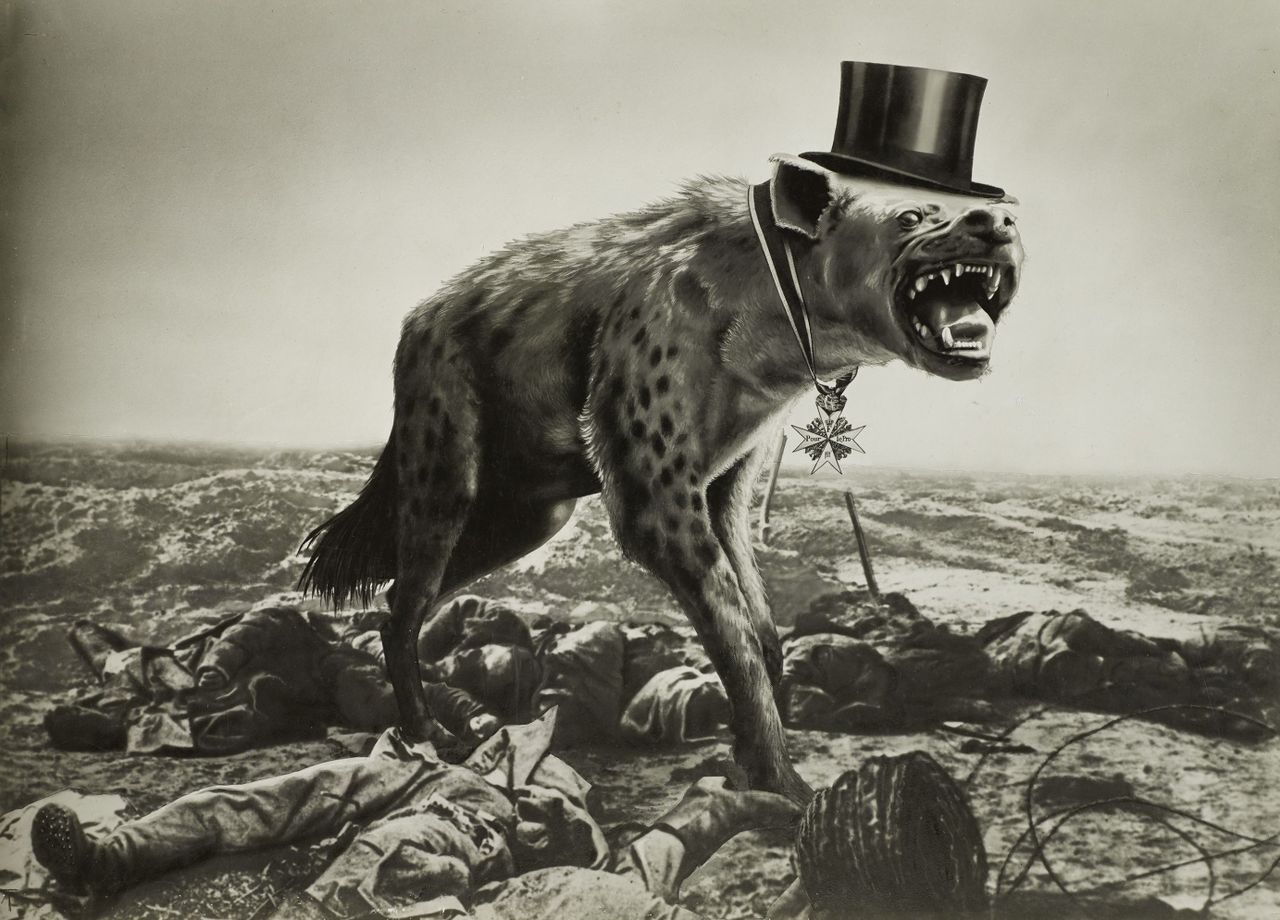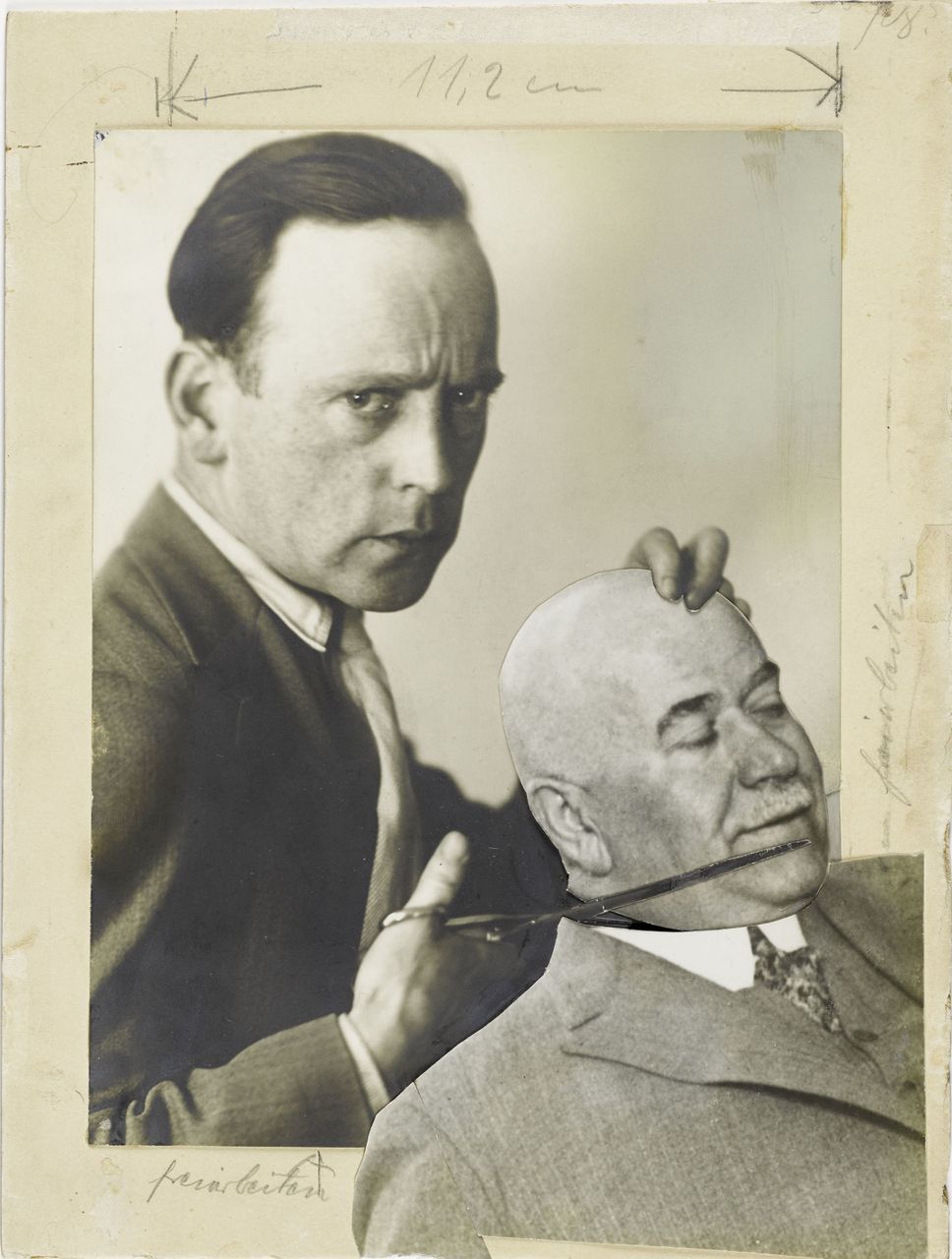The story of artist John Heartfield — born Helmut Franz Josef Herzfeld in Berlin in 1891 — begins like a German fairy tale. In 1899, his parents, ill and poverty-stricken, abandoned Helmut and his three siblings in a mountain cabin at Aigen, near Salzburg. The hungry children were discovered four days later by the mayor of the town and his wife, who took them in and fostered them. Meanwhile, their uncle, a lawyer, appeared with a trust from their wealthy grandfather’s estate to fund their educations.
Helmut trained at several art schools in Germany, eventually arriving at the School of Arts and Crafts in the bohemian Berlin of the 1910s, where he abandoned his dream of becoming a painter and instead invented hugely effective anti-war propaganda art during World War I and the rise of the Nazis. As The Canvas video above explains, Heartfield’s work pointedly encapsulates the “anti-bourgeois, anti-capitalist, anti-fascist” attitudes of radical Berlin Dadaists. He was “one of Hitler’s most creative critics.”
Herzfeld began his anti-war art campaign by anglicizing his name to counter rising anti-British sentiment at the start of World War I. As John Heartfield, he collaborated with his brother, Weiland, and satirical artist George Grosz on the leftist journal New Youth and the revolutionary publishing house, Malik Verlag. After the war, they joined the German Communist party. (Heartfield “received his party book,” writes Sybille Fuchs, “from KPD leader Rosa Luxemburg herself.”), and they became “founding members of the Berlin Dadaists,” developing the photomontage style Heartfield used throughout his graphic design career.

John Heartfield, War and Corpses, the Last Hope of the Rich
“Photomontage allowed Heartfield to create loaded and politically contentious images,” the Getty writes. “To compose his works, he chose recognizable press photographs of politicians or events from the mainstream illustrated press…. Heartfield’s strongest work used variations of scale and stark juxtapositions to activate his already gruesome photo-fragments. The result could have a frightening visual impact.” They also had widespread influence, becoming an almost standard style of radical protest art throughout Europe in the early part of the 20th century.
On rare occasions, Heartfield included photographs of himself, as in the self-portrait below with scissors clipping the head of the Berlin police commissioner; or he used his own photography, as in an unglamorous shot a young pregnant woman behind whose head Heartfield places what appears to be the body of a dead young man. The 1930 work protested Weimar’s anti-abortion laws with the title “Forced Supplier of Human Material Take Courage! The State Needs Unemployed People and Soldiers!” But most of his work disassembled and repurposed the popular press.

John Heartfield, Self-Portrait with the Police Commissioner Zörgiebel
Heartfield’s direct attacks on state power were allied with his support for worker movements. “In 1929, following tens years of activity in photomontage and publishing,” The Art Institute of Chicago writes, “John Heartfield began working for the left-wing periodical Worker’s Illustrated Magazine (Arbeiter-Illustrierte-Zeitung [AIZ]).” This weekly publication “served from the first as a major organ of opposition to the rising National Socialist Party.” Heartfield’s provocative covers mocked Hitler and portrayed the power of organized labor against the fascist threat. He traveled to the Soviet Union in 1931 under the magazine’s auspices and gave photomontage courses to the Red Army. His style spread internationally until the lifeless propaganda painting of Socialist Realism purged modernist art from the party style.
Unfortunately for Heartfield, and for Europe, the German left failed to present a unified front against Nazism as the KPD also became increasingly dogmatic and Stalinist. The artist and the editors of the AIZ were forced to flee to Prague when Hitler took power in 1933. (Heartfield reportedly escaped a “gang of Nazi thugs,” writes Fuchs, by leaping from his balcony in Berlin). In Czechoslovakia, he continued his counter-propaganda campaign against Hitler through the covers of the AIZ. When the Nazis occupied Prague in 1938, he fled again, to London but never stopped working through the war. He would eventually return to Berlin in the early 1950s and take up a career as a professor of literature.
Heartfield is a complicated figure — an overlooked yet key member of the German avant garde who, with his brother Weiland and artists like George Grosz revolutionized the media of photography, typography, and printing in order to virulently oppose war, oppression, and Nazism, despite the dangers to their livelihoods and lives. You can learn more about the artist’s life and work at the Official John Heartfield Exhibition site, which features many of the collages shown in the Canvas video at the top. (See especially the feature on Heartfield’s relevance to our current moment.) Also, don’t miss this interactive online exhibition from the Akademie Der Künste in Berlin, which controls the artist’s estate and has put a number of rare photos and documents online.
Related Content:
Education for Death: The Making of the Nazi–Walt Disney’s 1943 Film Shows How Fascists Are Made
Watch a Gripping 10-Minute Animation About the Hunt for Nazi War Criminal Adolf Eichmann
Josh Jones is a writer and musician based in Durham, NC. Follow him at @jdmagness

0 Commentaires